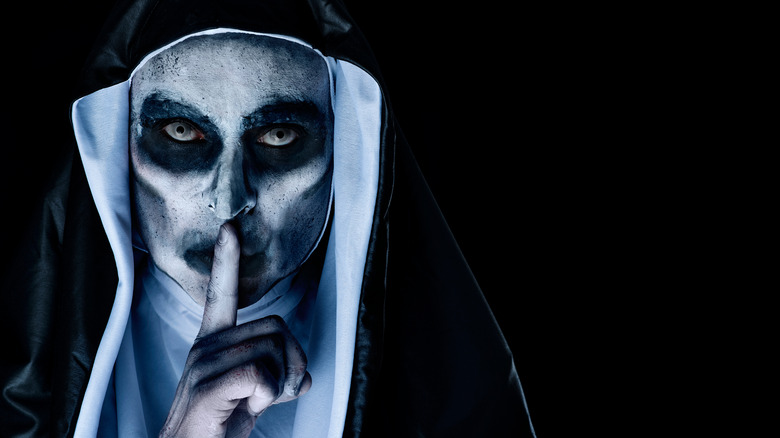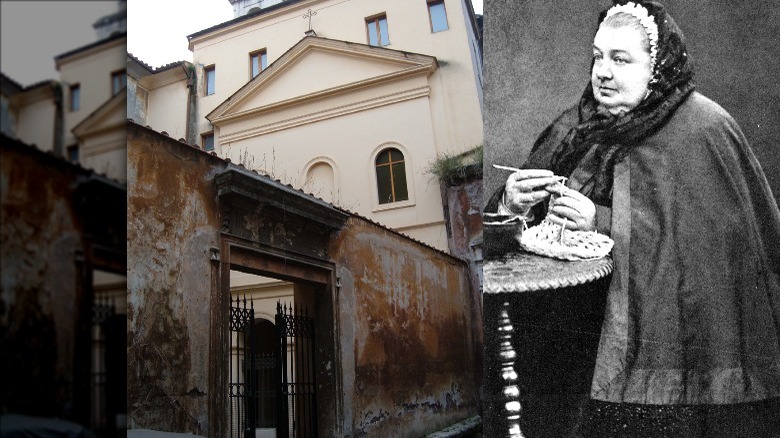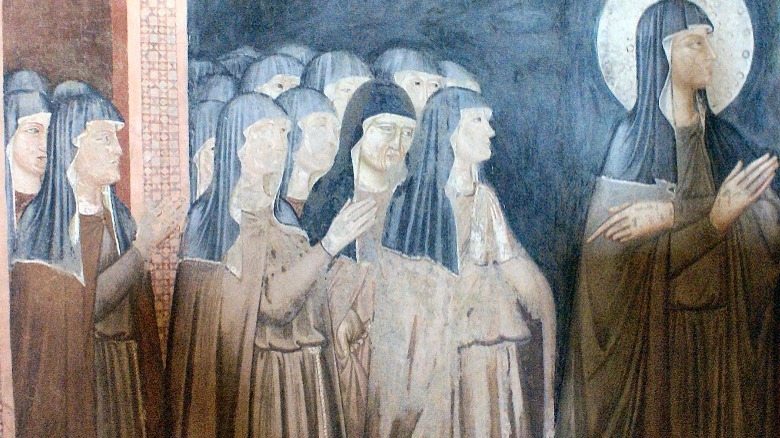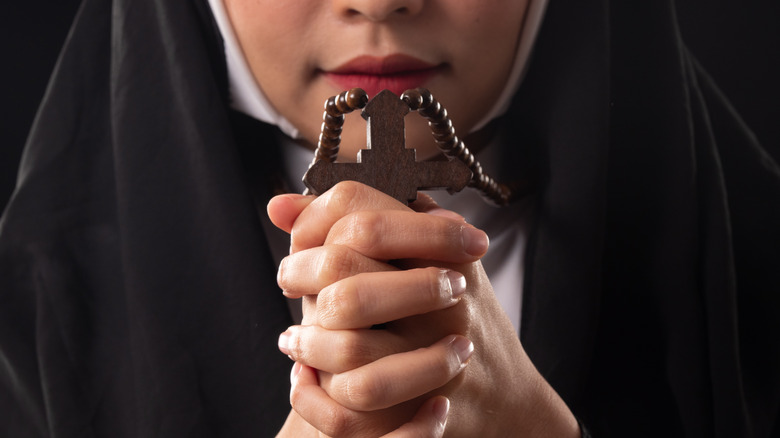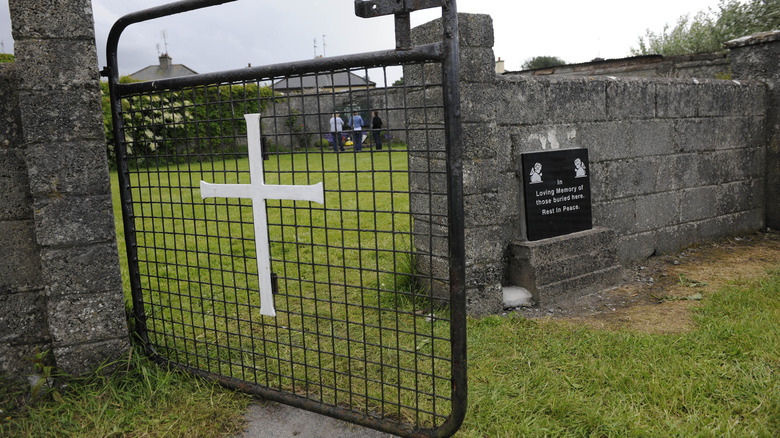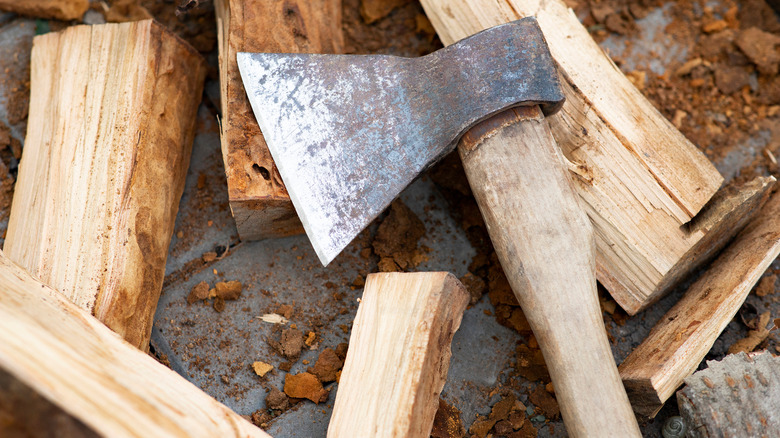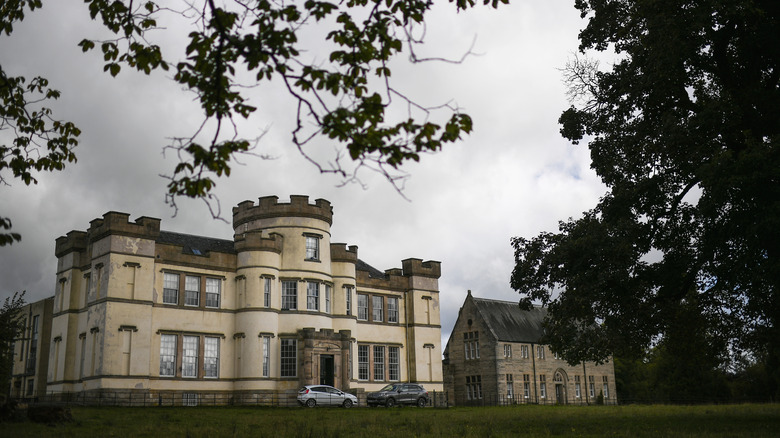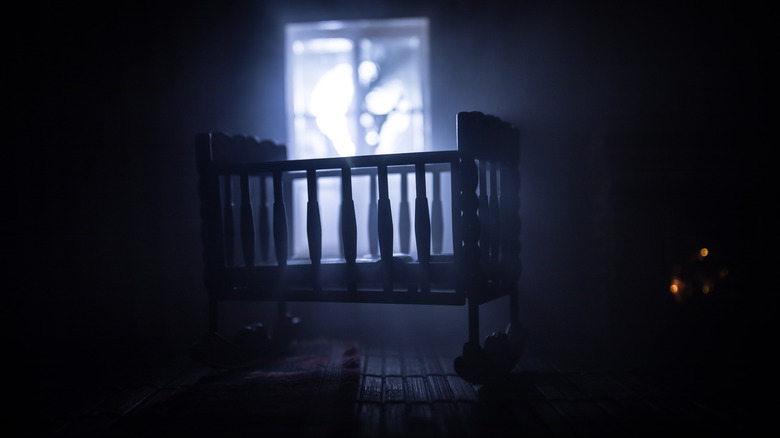The Most Infamous Killer Nuns
The idea of a nun is, on the surface, absolutely fine. In theory, they're women who have dedicated the entirety of their lives to the service of a higher power, and there's nothing wrong with that. It sounds quite honorable, in fact — so why can they be so terrifying?
Boston College's O'Neill Library says there's even a word for fear of nuns, and it's scenisciphobia. Anyone who suffers from it can rest easy in at least knowing they're not alone, and when KQED looked at why so many horror movies feature nuns, they found that part of it was the secrecy of convents that put the fear of God into people.
It's been that way for a long, long time — way back in the 14th century, Chaucer was writing about less-than-holy nuns.
Do some digging, and it'll quickly become clear that there's actually a good reason this fear is so widespread. Horror movies and fictional tropes aside, there are plenty of instances where nuns have killed those who put their faith in them ... and it's grisly stuff.
Maria Luisa and the nuns of Sant'Ambrogio
If it wasn't for Katherina von Hohenzollern-Sigmaringen (pictured) — the twice-widowed princess who became a nun and was assigned to the convent of Sant'Ambrogio in 1858 — there's no telling how high the body count would have been.
Katherina wrote a letter to her cousin just 15 months after entering the convent. It simply read, "Save me," and that's what he did. Once he moved her to one of his estates, she recorded the whole tale for the Vatican.
It started, says Commonweal, with Katherina's condemnation of the convent's abbess and her apparent tendency to fake stigmata in an attempt to be lauded as a living saint. She also had a problem with novice Maria Luisa, who had gotten a little too close with an American man who regularly visited, looking for "salvation." She also claimed Maria Luisa had tried to poison her when she complained, and when Pope Pius IX ordered an investigation, he found it was true.
In addition to uncovering activities including so-called "initiation rites" and the X-rated "Jesuit blessing," they also found nuns who were embezzling money to buy jewelry, then faking visions and letters they claimed they received from God. And then, there was the poisoning. While Katherina survived multiple attempts on her life, the inquiry found Maria Luisa had poisoned and killed three other nuns. The convent was closed forever, and Maria Luisa spent the next 20 years of her life cloistered in a monastery.
Sister Leticia Lopez
The body was discovered in the final months of 1999, says The Telegraph, and the remains were so badly mutilated that the victim wasn't identified as Sister Luz Amparo Granada for a shocking five months.
The nun was well-known in Bogota, particularly for her work with the city's addicts and sex workers. While a theory floated around that it was one of these men or women who had shot, dismembered, and then burned her, it wasn't long before police started looking at her own colleagues.
First and foremost was Sister Leticia Lopez, who was rumored to have looked down on the idea that one of her fellow sisters was befriending those who lived on the streets. There were also rumors that Sister Leticia had been involved with 21 vigilante-style murders, but law enforcement couldn't find anything to tie her to the murdered nun.
Until, that is, they asked the FBI for help. It was FBI technology that uncovered blood spray on the walls and floor of the convent's thoroughly scrubbed and recently repainted walls and floors, which all amounted to some indisputable evidence, says the Independent. The BBC later reported that Sister Leticia Lopez had been tried, convicted, and sentenced to 14 years in prison. She maintained her innocence.
Cecile Bombeek/Sister Godfrida
Cecile Bombeek was 15 years old when she decided to give her life to the Belgian convent called the Order of Holy Joseph. Taking the name Sister Godfrida, she found her calling working with the elderly, and it wasn't long before she became one of the most well-loved nuns. Eventually appointed Mother Superior, decades passed uneventfully — until, says The News, three other nuns went to the local police with some shocking claims.
According to Time, some of the nuns had gotten suspicious about some of the deaths that had happened in Sister Godfrida's nursing home. They started keeping a log, and there was one common denomination: the Mother Superior herself. What ultimately came out was that the nun wasn't just a fan of good food, fine wine, and love triangles, but that she had a cocaine and morphine habit as well.
Along with stealing somewhere in the neighborhood of $30,000 from patients, she also admitted to killing three people by administering a fatal dose of insulin. She claimed they were "too difficult at night" and very quickly tried the disclaimer that they hadn't suffered, as Time details. Investigations found that she'd taken the victims' assets to support her drug habits, which seemed to have developed only after she underwent major surgery to have a brain tumor removed, as per The News.
Sister Godfrida confessed to three murders, but detectives found it likely she killed as many as 30. In 1978, it was reported by UPI (via Unknown Misandry) that she was remanded to a private addiction clinic.
The Cavan orphanage fire
Killers can be killers without being murderers, and one of the distinctions is motive. The motive, says The Irish Times, is up for debate, but the facts are indisputable: When a fire broke out in a Cavan orphanage run by the nuns of the Poor Clare Convent, 35 orphan girls between the ages of 4 and 18 died in the blaze, while all of the nuns who had been in the building at the time survived.
The fire happened on February 23, 1943, and reports paint an understandably confusing picture. Survivors testified that by the time they woke up and realized something was horribly wrong, the smoke, heat, and flames were so thick that they couldn't make it down the stairs. Even those that did make it to the fire escapes found them locked — the nuns carried the keys — and here's where things get even more terrible.
Documentaries, summarizes The Journal, have since found witness testimony to support claims that when the fire started, the nuns in the building didn't take the opportunity to evacuate the girls when they still had an escape route. Why? They were afraid anyone who came to fight the fire would see the girls in their nightgowns.
Investigation ultimately cleared nuns of blame, citing other factors like the lack of a nearby fire brigade. Survivors had other issues, though, and as Ireland was debating abortion laws in 2018, the fire was used as an example of the church's historic treatment of women.
Mariam Soulakiotis/Mother Mariam
Mariam Soulakiotis is listed in "The Encyclopedia of Serial Killers," by Michael Newton, but there's an important footnote: They say that while she was sentenced for a range of felonies, murder wasn't among the charges.
Information is a little sketchy, and the case has sort of slipped through the cracks outside of the nation where it happened. That's pretty shocking, because even though it happened in Greece, reports — like one from a 1968 edition of the Cedar Rapids Gazette (via Unknown Misandry) — are nothing short of epically awful.
Mother Mariam was in charge of a rogue sect of nuns called The Calendarists, who had broken away from the Greek Orthodox Church in 1923. It wasn't until 1950 that their Mother Superior was arrested for a slew of charges that included assault, kidnapping, murder, and fraud. In addition to forcing new members to sign over their entire lives not to the convent but to her personally, investigations found that the fasts and penances she handed out resulted in the deaths of somewhere around 177 men and women, including a 22-year-old American tourist who disappeared in Athens.
A 1954 issue of the Morning Bulletin reported on Mother Mariam's death, adding that at the time she was arrested, she owned around 300 homes and a treasure trove of gold and jewelry. She was in prison serving a 16-year-sentence for the crimes that could be proven, while rumors that she hastened the deaths of those 177 remained — officially — rumors.
The Tuam Mother-and-Baby home
In 2012, Catherine Corless exposed the horrors of a mother-and-baby home in Galway. It was run, says the BBC, by the Bon Secours Sisters, and the town it was located in — Tuam — is aptly pronounced "Tomb."
Corless grew up not far from the home and remembered seeing the so-called "home babies" on her own walk to school. She was a grandmother herself when she started on an amateur historian's quest to learn more about the children there, and she found so many died there.
According to The New York Times, the St. Mary's Mother and Baby Home operated as a place for unmarried women to have their sons and daughters from 1925 to 1961. During those years, the nuns in charge of the place buried a child — on average — about every other week. Corless ultimately discovered that 798 children had died at the home, and it wasn't until Irish news outlets picked up on the fact that most had been simply buried in the mass grave — long thought to be a famine grave — that there was a massive investigation into the mother-and-baby homes that existed across the country for decades.
Survivors recounted cruelty at the hands of nuns, who — with one blow — could "put you into the middle of next week." They were raised with threats, the ever-present likelihood of sickness, and knowing nothing but neglect, hunger, and being told they were "children of the Devil." And in Tuam alone, 798 of them died there.
The Movement for the Restoration of the Ten Commandments of God
In 2000, The New York Times reported that there was only a single known survivor of the group called the Movement for the Restoration of the Ten Commandments of God — which they also called a "doomsday cult."
The Uganda-based cult taught that the world was going to end with the coming of the year 2000, and members believed they were going to be rewarded for their faith with a free pass into heaven. The world didn't end, though, and that's when things went sideways. Those who had given up all their worldly possessions suddenly realized that they needed that stuff to live, now that the world hadn't ended, and survivor Peter Ahimbisibwe explained, "The people who sold their property would inquire one by one. Whoever would inquire, they would disappear."
According to the BBC, the group was run by what experts called "a hierarchy of visionaries" that included the former sex worker Credonia Mwerinde and a handful of priests and nuns that had been defrocked from the mainstream Catholic Church but used their experience to give some clout to the visions of the end of days. When bodies started turning up, some were in the home of one such priest.
By July of 2000, The New York Times reported the final death toll: 778. Most were poisoned and buried in mass graves, while the five cult leaders fled before imminent arrest.
The exorcism of Maricica Irina Cornici
Requesting an exorcism isn't something that's done easily — there's a whole process of applications, investigations, and consultations with mental health professionals that's done first. Sometimes, people decide to skip that whole process, though, and that's what led to the 2005 death of a 23-year-old Romanian nun named Maricica Irina Cornici.
According to CBS, the nun first started to hear voices. She was originally diagnosed with and treated for schizophrenia: Her psychiatrist, Dr. Gheorghe Silvestrovici, explained, "She thought the devil was talking to her, and told her that she was a sinful person. ... she was probably having her first episode."
She was prescribed medication for her symptoms, but when they started again, four of her fellow nuns and one priest decided to take it upon themselves to perform an exorcism. Fox News reported that the nun died during the ritual, and during the process, they had chained her to a cross and left her — without water or food — for days.
The priest overseeing the ritual, Daniel Petru Corogeanu, was found guilty of her murder and sentenced to 14 years in prison. Three of the nuns who assisted him — Simona Bardanas, Adina Cepraga, and Elena Otel — received sentences of five years, while another — Nicoleta Arcalianu — was given eight years in prison.
Sister Sephy
CNN described the scene as it appeared in Kottayam, India: dropped slippers, a torn veil, and an ax. It didn't take long before they found the missing Sister Abhaya, where she had been dumped in the convent's well.
What happened ended up being pretty straightforward: The nun had walked in on fellow nun, Sister Sephy, and a priest, Father Thomas Kottoor, engaging in the sort of thing that nuns and priests are 100% not supposed to do. It ultimately came out that they had killed Sister Abhaya in order to keep their "illicit relationship" a secret, and what's really mind-numbing is how long it took for the truth to come out.
Her body was discovered in 1992, and in spite of her extensive injuries — including a fractured skull, nail marks on her neck, and multiple head wounds — it was initially ruled that she had committed suicide. It was only with intense pressure from Sister Abhaya's family that law enforcement kept searching, but still, it took forever. A 1993 inquiry supported the suicide theory, a 1996 investigation couldn't decide what happened, and it wasn't until 2009 that Kottoor and Sister Sephy were charged with her death. It was another 10 years before they went to trial, and according to The Times of India, they were finally found guilty in 2020.
Smyllum Park
Smyllum Park opened in 1864. Located in Scotland and run by the Daughters of Charity of St. Vincent de Paul, it closed in 1981. The memories of what happened there were still incredibly powerful, and in 2018, The Guardian reported on an investigation into the mass grave discovered nearby. In it were the remains of as many as 400 children, reportedly victims of abuse and neglect handed down by the facility's overseers.
Among those who later testified was "Victor," a Smyllum Park survivor who said (via The Scotsman) the nuns there "routinely attempted to beat his 'Jewishness' out of him," and occasionally punished him by forcing him to eat his own vomit.
It was also Victor who testified to the unknown fate of his friend, who disappeared after being forced to stand in the rain: It was punishment for playing ball on a Sunday. He recalled, "I could hear him crying out in the night. He was so cold. I think the nun came and told him to shut up. ... I never saw him again. It still haunts me to this day. It's probably the worst thing that happened at Smyllum ... and I don't know to this day what happened to him."
Lawyers for the Daughters of Charity issued a "most sincere and heartfelt apology," which obviously wasn't good enough. Five workers — including the nun Margaret Bannerton — were arrested and charged. Survivors, the Daily Record says, were still waiting for their day in court when COVID hit.
The Bessborough Mother-and-Baby Home
During the 1930s, Cork's Bessborough mother-and-baby home had the highest infant mortality rate of all of these church-run homes — and, as RTE notes, none of those homes were what anyone would consider acceptable. A 2021 inquiry found that not only did 923 children die there, but in some years — like 1943 — three out of every four babies born there would not survive.
Bessborough was — like the other mother-and-baby homes in Ireland — where unmarried women went to have their children. The BBC says they stayed until their children were adopted — which could have taken years — and worked to pay off their debt to the house.
Also as with other such homes, it was run by nuns. Bessborough was the domain of the Sisters of the Sacred Heart, and when Dr. James Deeny learned what was going on there, he didn't just start firing nuns, he appealed for the closure of the entire facility. In his 1989 memoir, he described the conditions (via the Irish Independent): "Every baby had some purulent infection of the skin and all had green diarrhoea, carefully covered up. ... The deaths had been going on for years. They had done nothing."
Others who had worked there wrote that things like pain relief and penicillin were forbidden by attending nuns, who believed those sent to the home needed to "suffer the pain" in order to "atone for their sin." The BBC says the facility didn't close until 1998.
